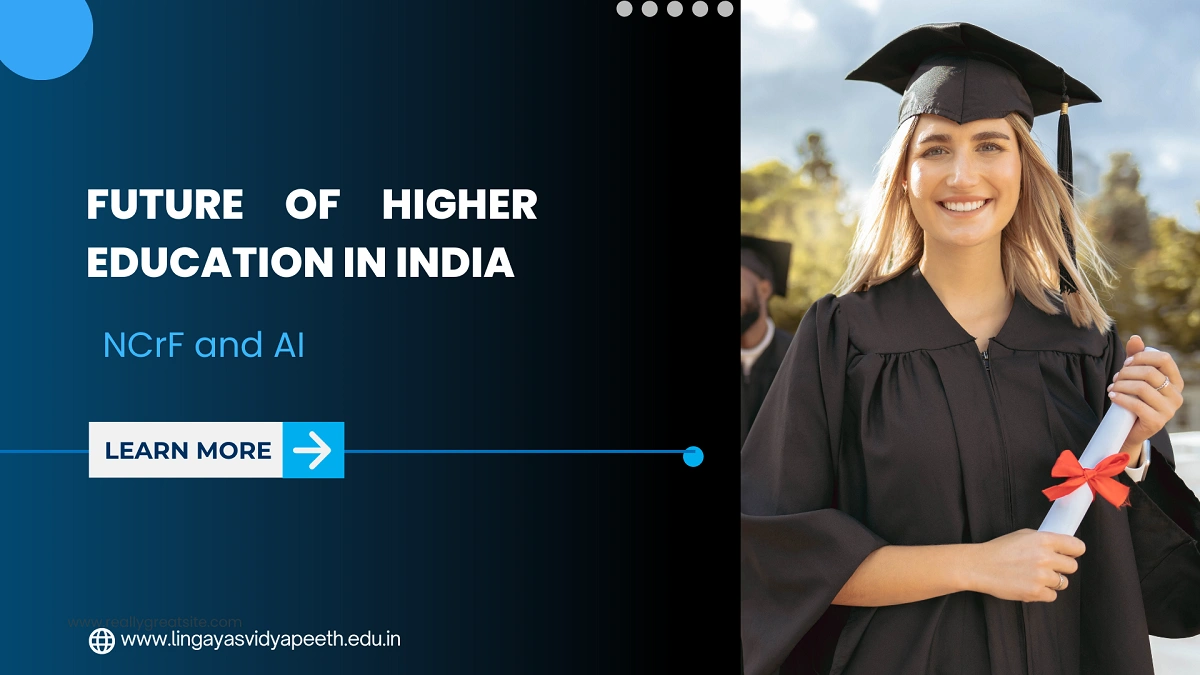Home » Future of Higher Education in India: NCrF and AI

Have you ever wondered what college life will look like just a few years from now? India’s higher education system is transforming quickly, and 2025 is set to be a big year. With the National Credit Framework (NCrF), artificial intelligence (AI), and hands-on learning becoming the new normal, studying won’t just mean memorizing textbooks anymore. It’s about gaining skills that prepare you for real jobs and life beyond the classroom.
In this blog, let’s break down what these changes mean for you—and why the future of learning in India is looking more exciting than ever.
First up, the National Credit Framework (NCrF). Launched in 2022 as part of the National Education Policy (NEP) 2020, NCrF changes how your learning is measured. Instead of only getting credits for classroom subjects, you also earn points for things like skill training, online courses, and workshops.
Think of NCrF as a bank account for your learning. Every new skill or course you complete adds credits to your account, which you can then use toward your degree. Even better, if you switch schools or courses, your credits move with you—so you don’t have to start from scratch.
Here’s why NCrF matters:
By 2025, NCrF is rolling out in schools (starting from Class 9) and expanding into universities. Experts say more than 50 million students could benefit. In short, it’s turning education into something both practical and meaningful.
Next comes artificial intelligence (AI)—your future study buddy. AI is already helping Indian universities personalize learning, and by 2025, it will be everywhere.
Here’s how it works: AI studies your learning style and creates a customized plan. Struggling with math? It gives you extra practice. Flying through history? It offers advanced resources. Early reports show students using AI tools achieve up to a 62% improvement in test scores and remember information 40% better.
Some AI-driven trends you’ll see in 2025:
Of course, there are challenges like data privacy and concerns about replacing teachers. But experts believe AI won’t take away teachers’ jobs—it will give them more time to focus on creativity and mentoring. By investing in AI training for educators, India is preparing for this shift.
The third big change is learning by doing. Called experiential or hands-on learning, this approach is about applying knowledge in real situations instead of just reading about it.
Under NEP 2020, colleges now emphasize projects, internships, fieldwork, and skill-based courses. For example, instead of only studying engineering theories, students might build real machines or solve live problems in their communities.
Why is this important? Because jobs today demand more than degrees. A recent survey found that 80% of employers in India want graduates with practical experience. To meet this demand, universities are offering micro-credentials—short, skill-focused certificates that make your resume stand out.
Hands-on learning helps students:
By 2025, many colleges will partner with industries to ensure students graduate with both knowledge and skills.
So how do these three changes come together? Simple:
Imagine this: You complete an AI-led project on renewable energy, earn credits under NCrF, and then use those skills in an internship with a green-tech company. That’s how India’s 35 million college students will stay globally competitive.
Yes, challenges like access to technology remain. But with government investment and UGC guidelines, the system is moving in the right direction.
The future of higher education in India is about freedom, skills, and opportunities. With NCrF, AI, and real-world learning shaping colleges, your journey won’t just be about passing exams—it will be about building a life you’re excited about.
So, keep an open mind, explore new tools, and embrace change. Education in 2025 is about to get smarter, more practical, and a lot more fun.
Also Read
HR Tech Trends 2025: Building Smarter, Personal Careers
Global Student Prize 2025: Bihar’s Adarsh Kumar Becomes India’s Pride
India’s First Gold in Speed Skating Worlds: Anandkumar Velkumar
AICTE Launches Project PRACTICE 2025 to Build Job-Ready Skills
RECENT POSTS
CATEGORIES
TAGS
Agriculture Agriculture future AI Architecture artificial intelligence Bachelor of Commerce BA English BA Psychology BTech AIML BTech CSE BTech cybersecurity BTech Engineering Business management career Career-Specific Education career guide career option career scope Civil engineering commerce and management Computer Science Computer science engineering Data science degree education Engineering Engineering students English Literature english program Fashion Design Fashion design course Higher Education Journalism journalism and mass communication law Law career Machine Learning mathematics MBA MBA specialization Mechanical Engineering Pharmacy Psychology Research and Development students
Nachauli, Jasana Road, Faridabad, Haryana
Address: C-72, Second Floor, Shivalik, Near Malviya Nagar,
Above HDFC Bank, New Delhi 110017
Landline No. - 011-46570515 / 45138169 / 41755703
Mobile No. - +91-7303152412 / +91-7303152420 / +91-9311321952
Toll Free: 1800-120-4613
Mobile : 8447744303 | 8447744304 | 8447744306 | 8447744309
8700003974 | 8700003411 | 8700003749
Copyrights © 1998 - 2025 Lingaya's Vidyapeeth (Deemed To Be University). All rights reserved.
LV only conducts physical/online verification of any document related to examination on the following email id:
It is important to note that the following email IDs and domains are fraudulent and do not belong to our university.